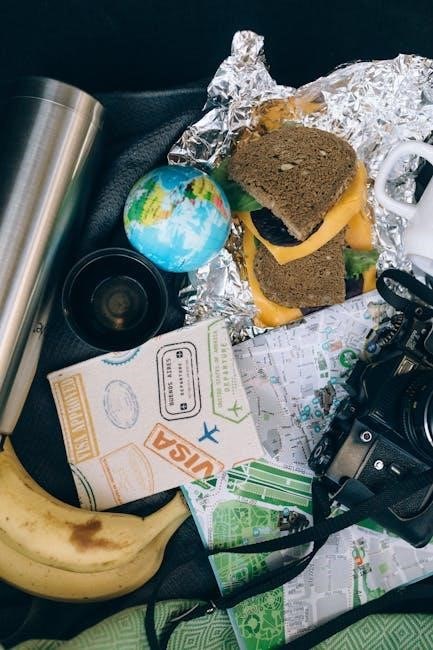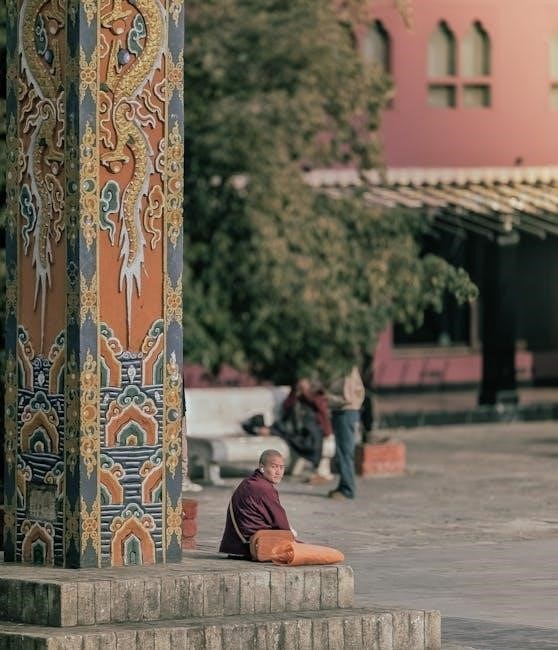dungeons and dragons monk guide
The Monk is a versatile martial artist, blending physical prowess with spiritual focus. Harnessing Ki, they deliver devastating strikes, dodge attacks with precision, and inspire allies, making them a dynamic and essential party member in any adventure.
Core Concepts and Role in the Party
Monks embody a harmonious blend of martial prowess and spiritual discipline, channeling their Ki to perform extraordinary feats. They excel as both melee combatants and versatile support characters, offering mobility, damage, and utility. Their ability to harness energy allows them to heal, protect, and inspire allies, while their agility and speed make them formidable opponents in close quarters. Monks thrive in dynamic combat situations, excelling at controlling crowds, dealing precision strikes, and outmaneuvering foes. As a key party member, the Monk bridges the gap between fighter and spellcaster, providing a unique balance of physical and mystical capabilities that enhance the group’s overall effectiveness in any adventure.

Key Features of the Monk Class
Monks excel in hand-to-hand combat, utilizing Ki to perform extraordinary feats. Key features include Martial Arts, Flurry of Blows, Evasion, and mobility enhancements, making them versatile combatants.
Martial Arts and Ki
Martial Arts and Ki are the cornerstone of the Monk’s power. At level 1, Monks gain access to Martial Arts, allowing them to use Dexterity for attack and damage rolls with unarmed strikes and monk weapons. Additionally, Monks harness Ki, an internal energy that fuels their abilities. By spending Ki points, Monks can perform extraordinary feats like Flurry of Blows, which grants an extra attack, or Patient Defense, enhancing their AC. Ki also enables advanced techniques such as Evasion, Slow Fall, and Stunning Strike, making Monks versatile combatants; As Monks progress, their Ki pool expands, unlocking more powerful abilities that blend martial prowess with mystical energy.
Unarmed Strike and Monk Weapons
Monks excel in hand-to-hand combat, with unarmed strikes serving as their primary weapon. At level 1, Monks can roll a d4 in place of the normal damage for their unarmed strikes or monk weapons. This die increases as they gain levels, reaching a d10 by level 17. Monks also gain proficiency with short swords and quarterstaffs, which complement their martial prowess. Their unarmed strikes are considered finesse weapons, allowing them to use Dexterity for attack and damage rolls. This versatility makes Monks deadly in close combat, whether using fists or weapons, and enhances their ability to adapt to various combat scenarios with precision and force.

Choosing the Right Race for Your Monk
Selecting the right race enhances a Monk’s abilities. Races like Tabaxi or Wood Elf boost Dexterity, crucial for attack and AC, while others offer Wisdom increases, vital for Ki and perception, ensuring a well-rounded character.
Optimal Race Selection for Monks
When selecting a race for your Monk, prioritize Dexterity and Wisdom. Races like Lightfoot Halfling or Wood Elf offer Dexterity boosts, enhancing attack and AC. Dragonborn and Goliath provide Strength, useful for melee-focused builds. Half-Elf or Human are versatile, offering balanced ability scores. Tabaxi gain extra Dexterity and can climb walls, ideal for mobility. Monk subclasses like Way of the Shadow benefit from Drow’s stealth bonuses. Consider racial traits that complement your playstyle and subclass, ensuring optimal synergy between race and class features for a powerful, cohesive character.
Monk Subclasses and Their Unique Abilities
Monks can choose from several subclasses, each offering unique abilities. These subclasses redefine their role, providing distinct playstyles for combat, mobility, or support in D&D 5e.
Way of the Open Hand
The Way of the Open Hand monk focuses on enhancing mobility and dealing massive melee damage. At level 3, they gain the Open Hand Technique, which allows them to knock a creature prone or push it up to 10 feet away with an unarmed strike. This subclass also introduces the Wholeness of Body feature at level 6, granting the ability to heal using Ki. At higher levels, Slow Fall and Tempest Strike add versatility, making this subclass ideal for players seeking a balance between offense and defense while emphasizing fluid, dynamic combat.
Way of the Shadow
The Way of the Shadow monk excels at stealth, deception, and manipulating darkness. At level 3, they gain Eclipse, allowing them to enter a shadowy form, becoming invisible in dim light. The Passing Shadow feature at level 6 enables teleportation through shadows, enhancing mobility. At level 11, Close to the Shadow grants advantage on stealth checks and resistance to being charmed. Finally, Perfect Cloak of Shadows at level 17 makes their invisibility in shadows permanent. This subclass is perfect for players who enjoy playing a cunning, elusive character, mastering the arts of ambush and misdirection while blending seamlessly into the shadows.

Ability Scores and Skill Selection
Dexterity and Wisdom are crucial for Monks, as they enhance AC, attack rolls, and key class features. Prioritize these scores for optimal performance in both combat and exploration.
_priority for Monks
Ability Score Priority for Monks
Dexterity and Wisdom are the primary abilities for Monks, as they enhance attack rolls, AC, and key class features like initiative and perception. Prioritize Dexterity for melee effectiveness and Wisdom for survivability and Ki manipulation. Constitution is secondary, boosting health and endurance, crucial for maintaining combat stamina. Strength is less important unless focusing on specific builds. Charisma and Intelligence are tertiary, useful for social interactions or skill checks but not essential. Balancing these scores ensures a well-rounded Monk, capable of excelling in both combat and exploration. Proper allocation maximizes the class’s martial and mystical potential, making the Monk versatile and formidable in any adventuring party.
Crucial Skills for Monks
Monks excel when proficient in skills that complement their agility, discipline, and perception. Acrobatics is essential for maintaining balance and avoiding opportunity attacks, while Athletics aids in climbing, jumping, and grappling. Insight and Intimidation are vital for understanding enemies and manipulating social dynamics. Perception ensures awareness of hidden threats, and Stealth allows Monks to move undetected, setting up ambushes or avoiding danger. Proficiency in these skills enhances a Monk’s versatility in both combat and exploration. Selecting the right skills ensures the Monk remains a formidable and adaptable character, capable of addressing challenges in creative and effective ways, making them indispensable to any party.
Equipment and Gear for Monks
Monks rely on unarmed strikes and ki for combat, but often wield clubs, quarterstaffs, and light armor. Their gear emphasizes mobility and flexibility, enhancing their martial prowess and versatility in battle.
Weapons and Armor
Monks are proficient with unarmed strikes and a selection of monk weapons, such as clubs, quarterstaffs, and short swords. They can also use light armor, but often prefer no armor to maintain their Dexterity bonus. At higher levels, their unarmed damage scales with their class level, making their fists as deadly as any weapon. The choice of gear should complement their martial style, whether focusing on mobility, stealth, or raw power. Proper equipment enhances their combat effectiveness without hindering their agility or Ki-based abilities, ensuring they remain versatile and formidable in any situation. Their gear reflects their disciplined and efficient approach to warfare.
Adventuring Gear
Monks often prioritize practicality and mobility in their adventuring gear. A explorer’s pack or burglar’s pack is ideal, containing essentials like a bedroll, rations, and rope. For stealth-focused monks, items like thieves’ tools or a cloak of invisibility can enhance their sneak capabilities. A herbalism kit complements their emphasis on health and recovery, while alchemist’s supplies can aid in crafting remedies. Lightweight gear like grappling hooks or climbing equipment supports their agility-based playstyle. Some monks may carry holy symbols or focal points for meditation, reinforcing their spiritual connection. Gear choices should enhance their mobility, stealth, and versatility without compromising their martial prowess or Ki-based abilities.

Playstyle and Combat Tactics
Monks excel at high mobility and Ki manipulation, using agility to outmaneuver foes. They balance offense with defensive techniques like Evasion, making them versatile in both dealing damage and avoiding it, while supporting allies with martial precision.
Optimizing Your Monk in Combat
Monks thrive in combat by leveraging their mobility, Ki, and martial prowess. Focus on positioning to maximize Flurry of Blows and maintain advantage through high Dexterity. Use Stunning Strike to incapacitate foes early, while techniques like Evasion and Disengage enhance survivability. Prioritize Wisdom to fuel Ki abilities and Dexterity for attack efficiency. Maintain movement flexibility to avoid attacks and strike from optimal angles. Utilize Stances like Way of the Shadow for stealth or Open Hand for crowd control. Coordinate with allies to set up flanking opportunities and control enemy movements. Balance offense with defense, using Ki sparingly to sustain combat effectiveness. Monks excel when combining agility, precision, and strategic Ki use, making them formidable in both melee and ranged scenarios.

